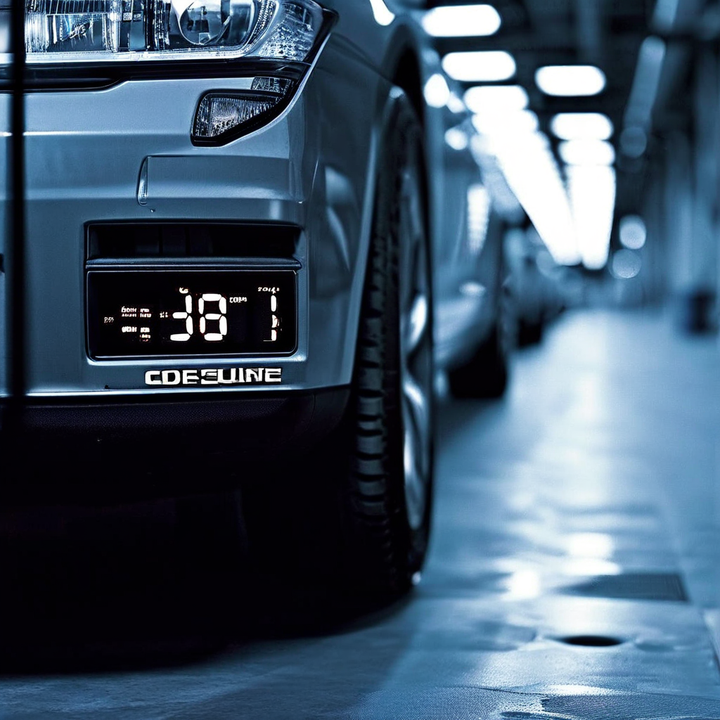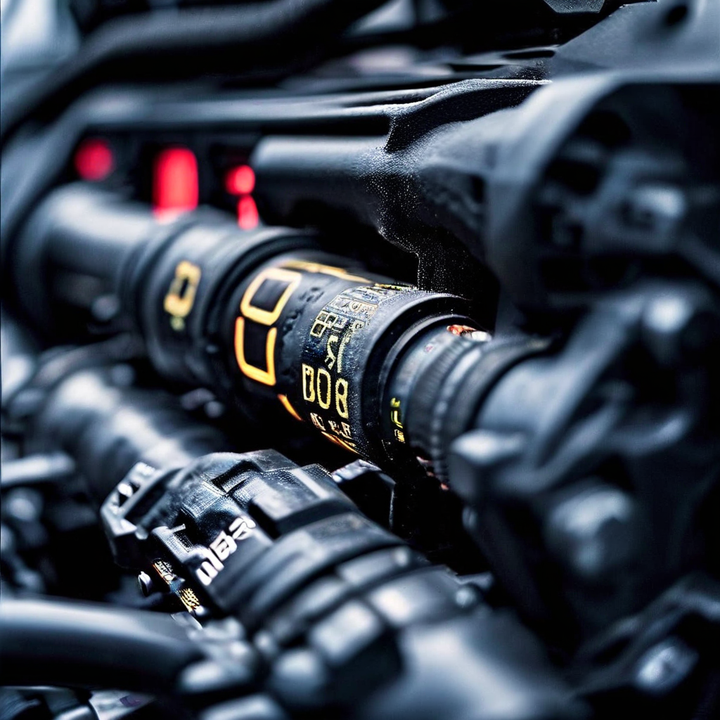


The diagnostic trouble code (DTC) P03C4 stands for "Cylinder 5 Pressure Variation Low". This code is set when the powertrain control module (PCM) detects an abnormal low variation in the cylinder pressure for cylinder number 5 of the engine.
Before we dive into the nitty-gritty details, let's first grasp the essence of this code. The P03C4 is a diagnostic trouble code (DTC) that specifically relates to the engine's cylinder pressure monitoring system. This sophisticated system continuously evaluates the pressure variations across all cylinders, ensuring they operate within an acceptable range.
When the pressure variation in cylinder 5 falls below the expected threshold, the engine control module (ECM) triggers the P03C4 code, alerting you to a potential issue. It's like a warning light, signaling that something isn't quite right with the fifth cylinder's performance.
As with any diagnostic code, the P03C4 can stem from various underlying causes. Through years of experience, I've identified several common culprits that can contribute to this issue:
| Cause | Description |
|---|---|
| Low Cylinder Compression | One of the primary suspects is low compression in cylinder 5, which can be caused by worn piston rings, burned valves, or other mechanical issues within the cylinder. When compression is compromised, the cylinder's ability to generate adequate pressure is hindered, leading to the dreaded P03C4 code. |
| Vacuum Leaks | Vacuum leaks around the intake manifold gaskets or vacuum hoses near cylinder 5 can also be the root cause. These leaks allow unmetered air to enter the system, disrupting the delicate balance of air and fuel mixture, ultimately affecting cylinder pressure. |
| Faulty Fuel Injector | A malfunctioning fuel injector for cylinder 5 can lead to insufficient fuel delivery, resulting in an imbalance in the air-fuel ratio and, consequently, low cylinder pressure. |
| Catalytic Converter Restrictions | A clogged or restricted catalytic converter can create back pressure, hindering the engine's ability to expel exhaust gases efficiently. This back pressure can ripple through the system, affecting cylinder pressure and triggering the P03C4 code. |
| Ignition System Issues | Problems with the ignition system, such as faulty spark plugs, coil packs, or wiring related to cylinder 5, can disrupt the combustion process, leading to low cylinder pressure and the dreaded code. |
| Low Fuel Pressure | A failing fuel pump or a clogged fuel filter can cause low fuel pressure, preventing the engine from delivering the required amount of fuel to cylinder 5, ultimately affecting its pressure. |
As a seasoned mechanic, I understand the importance of a thorough diagnostic process to pinpoint the exact cause of the P03C4 code. Here's my tried-and-true approach:
The first step is to perform a cylinder compression test, specifically for cylinder 5. Low compression readings can indicate internal engine issues, such as worn piston rings or valves, which may require more extensive repairs.
During this test, a compression gauge is connected to the spark plug hole of cylinder 5, and the engine is cranked over several revolutions. The gauge will display the maximum compression achieved within the cylinder. Typical compression readings for a healthy engine should fall within the manufacturer's specified range, usually between 100 and 200 PSI.
If the compression reading for cylinder 5 is significantly lower than the other cylinders or outside the recommended range, it's a strong indication of internal mechanical issues within that cylinder.
Next, I'll check for vacuum leaks around the intake manifold gaskets and hoses using specialized tools like an automotive vacuum gauge or a carburetor cleaner mist test. Even the smallest leak can wreak havoc on cylinder pressure.
To perform the vacuum gauge test, I'll connect the gauge to the intake manifold while the engine is running. A steady vacuum reading indicates no leaks, while a fluctuating or dropping reading suggests the presence of a vacuum leak.
Alternatively, the carburetor cleaner mist test involves spraying a fine mist of carburetor cleaner around the intake manifold gaskets and hoses while the engine is idling. If there's a vacuum leak, the mist will be drawn into the engine, causing a noticeable change in the engine's idle speed or sound.
Inspecting the fuel injector for cylinder 5 and checking the fuel pressure with a dedicated fuel pressure gauge is crucial. Low fuel pressure can point to a fuel delivery problem, which may be the root cause of the P03C4 code.
To check the fuel pressure, I'll connect the fuel pressure gauge to the appropriate test port on the fuel rail or fuel line. With the engine running, the gauge should display the manufacturer's specified fuel pressure range, typically between 35 and 60 PSI.
If the fuel pressure is low, it could indicate a failing fuel pump, clogged fuel filter, or a restriction in the fuel delivery system specific to cylinder 5.
I'll also check for any trouble codes related to the ignition system, fuel system, or catalytic converter. These components can indirectly affect cylinder pressure and contribute to the P03C4 code.
Using a diagnostic scan tool, I'll retrieve and analyze any stored trouble codes related to the ignition system, such as misfire codes or issues with the coil packs or spark plugs. These codes can provide valuable insights into potential ignition system faults that may be causing the low cylinder pressure.
In some cases, a relative compression test may be necessary to isolate issues between cylinders and identify any significant deviations in cylinder pressure.
During this test, the compression of each cylinder is measured and compared to the others. If cylinder 5 exhibits a significantly lower compression reading relative to the other cylinders, it confirms that the issue is specific to that cylinder and not a broader engine problem.
Once the root cause has been identified, it's time to roll up our sleeves and get to work. The repair process will vary depending on the diagnosed issue:
| Repair | Description |
|---|---|
| Low Compression Repairs | If low compression is the culprit, repairs may involve replacing piston rings, valves, or potentially an engine rebuild or replacement in severe cases. These repairs can be costly but are necessary to restore proper cylinder pressure and engine performance. |
| Vacuum Leak Fixes | Vacuum leaks require replacing gaskets or damaged vacuum hoses around cylinder 5. This relatively straightforward repair can often resolve the P03C4 code effectively. |
| Fuel System Overhaul | A faulty fuel injector will need to be replaced, and clogged fuel filters should also be changed to ensure proper fuel delivery. |
| Ignition System Repairs | If the issue lies within the ignition system, replacing spark plugs, coil packs, or wiring related to cylinder 5 may be necessary to restore proper combustion and cylinder pressure. |
| Catalytic Converter Replacement | In cases where a restricted catalytic converter is causing back pressure, a replacement may be required to eliminate the obstruction and restore proper exhaust flow. |
To prevent future occurrences of the P03C4 code, I always recommend following these preventive measures:
Adhere to the manufacturer's recommended service intervals for spark plugs, air filters, and other maintenance items.
Use high-quality fuel and keep fuel levels reasonably full to avoid running low on fuel, which can contribute to cylinder pressure issues.
Address any drivability issues, such as misfires, promptly to prevent further damage and potential cylinder pressure variations.
Avoid aggressive driving that can cause excessive cylinder pressures and premature wear on engine components.
Regularly inspect and replace worn or damaged vacuum hoses and gaskets to prevent vacuum leaks.
The repair cost associated with the P03C4 code can vary significantly based on the root cause. Here's a general cost breakdown:
| Repair | Estimated Cost Range |
|---|---|
| Gasket/Hose Replacements | $100 - $300 |
| Fuel Injector Replacement | $200 - $500 |
| Ignition System Repairs | $200 - $800 |
| Catalytic Converter Replacement | $800 - $1,500 |
| Piston Rings/Valve Job | $1,500 - $3,000 |
| Engine Rebuild/Replacement | $3,000 - $6,000+ |
It's important to note that these costs are estimates and can vary based on factors such as the make and model of the vehicle, labor rates in your area, and the specific repair shop you choose.
Proper diagnosis is crucial to avoid unnecessary repairs and ensure that the underlying issue is addressed effectively. I always recommend seeking multiple quotes from reputable repair shops to ensure you receive fair pricing and quality workmanship.
In conclusion, the P03C4 code may seem daunting at first, but with the right knowledge and diagnostic approach, it can be resolved effectively. Remember, preventive maintenance and addressing issues promptly can go a long way in avoiding costly repairs and ensuring your vehicle's optimal performance.
Happy motoring, and may your cylinders always maintain the perfect pressure!
The P03C4 code indicates low cylinder pressure variation in cylinder 5. Common causes include low compression, vacuum leaks, faulty fuel injector, catalytic converter restrictions, ignition issues, and low fuel pressure.
Perform a cylinder compression test, check for vacuum leaks, inspect the fuel injector and pressure, retrieve related trouble codes, and conduct a relative compression test.
Depending on the diagnosed cause, repairs may involve replacing piston rings, valves, gaskets, fuel injector, spark plugs, catalytic converter, or potentially an engine rebuild.
Follow recommended maintenance intervals, use high-quality fuel, address drivability issues promptly, avoid aggressive driving, and regularly inspect vacuum hoses and gaskets.
The repair cost can range from $100 for gasket replacements to $6,000 or more for an engine rebuild, depending on the root cause.
Yes, a cylinder compression test, specifically for cylinder 5, is crucial to identify potential internal mechanical issues causing low compression.
Yes, vacuum leaks around the intake manifold gaskets or vacuum hoses near cylinder 5 can disrupt the air-fuel mixture and lead to low cylinder pressure.
Yes, a malfunctioning fuel injector for cylinder 5 can cause insufficient fuel delivery, resulting in an imbalance in the air-fuel ratio and low cylinder pressure.
Yes, a clogged or restricted catalytic converter can create back pressure, hindering exhaust flow and affecting cylinder pressure, potentially causing the P03C4 code.
In some cases, a relative compression test may be required to isolate issues between cylinders and identify significant deviations in cylinder pressure.

Miguel started tinkering with car radios as a teenager, fascinated by the intricate dance of wires and circuits. This passion led him to pursue a career as an automotive electrician. For the past 10 years, Miguel has tackled everything from flickering headlights to mysterious electrical gremlins. He thrives on troubleshooting electrical problems and enjoys sharing his knowledge to empower car owners to understand their vehicles better.



